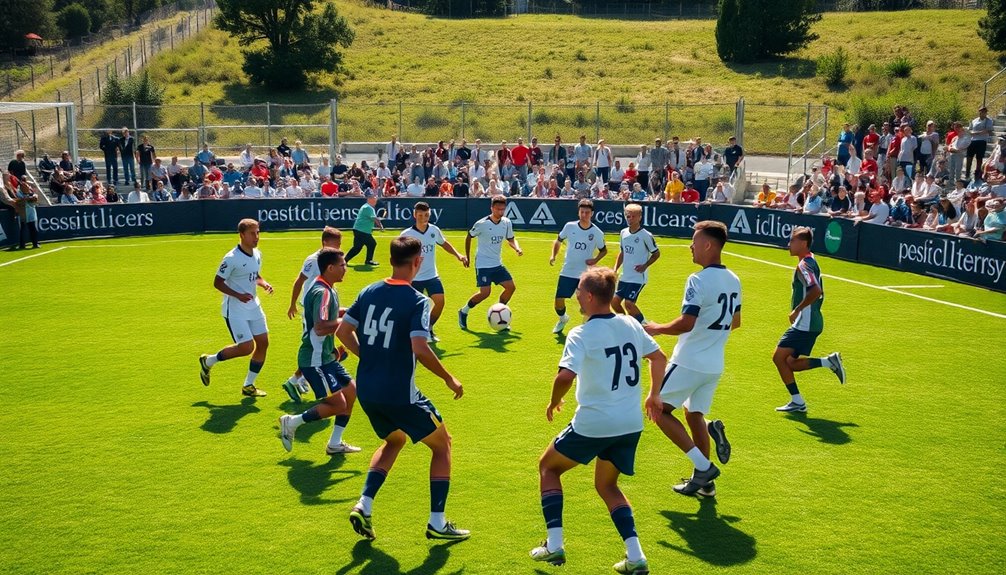
The Art of the Soccer Rondo: A Tactical Masterpiece
March 19, 2025The art of the soccer rondo is all about mastering possession and enhancing your tactical understanding. It helps you develop technical precision, quick decision-making, and teamwork skills in a dynamic environment. By engaging in rondos, you learn to communicate better with teammates and adapt to various game scenarios. Plus, you'll build confidence as you tackle competitive situations. Discover how integrating rondos into your training can elevate your game and transform your approach to soccer.
Understanding the Rondo Concept
When you plunge into the rondo concept, you'll quickly notice it's more than just a simple ball possession drill.
Players love the dynamic nature of these exercises, where a group maintains possession while a smaller team attempts to intercept the ball. This training session emphasizes communication and teamwork, forcing players to work together to create openings against defenders. Understanding positions is crucial in maximizing effectiveness during these drills, as players must also develop their endurance levels to sustain high-intensity efforts throughout the exercise.
With various formations and player numbers, rondos adapt to different age groups and skill levels, making them versatile tools in coaching. They focus on quick ball movement and spatial awareness, helping players develop essential technical skills. Incorporating step-over techniques can further enhance players' ability to evade defenders during these exercises.
The Importance of Technical Precision
Rondos aren't just about maintaining possession; they also hinge on technical precision, which profoundly impacts a player's performance on the field.
When you practice rondos, you're honing your ability to execute accurate passes and control the ball under pressure. This skill is essential when you need to go quick during a match. Additionally, incorporating speed and agility drills during your training can further enhance your effectiveness in tight situations. These drills, such as Pain Shuttles Drill, can significantly improve your cardiovascular endurance and anaerobic capacity.
As you engage in these drills, you'll develop quick, precise decision-making and learn to read the game effectively. The repetitive nature of rondos builds muscle memory, making techniques like receiving the ball second nature.
Teams that prioritize these exercises consistently show improved passing accuracy and ball retention. Close ball control is vital for navigating tight spaces during competitive play.
Ultimately, mastering technical precision boosts your confidence, encouraging creativity and risk-taking in competitive play.
Enhancing Tactical Awareness in Players

Rondos sharpen your decision-making under pressure by forcing you to act quickly with the ball.
As you engage in these drills, you'll notice how crucial communication is among teammates, helping everyone develop spatial awareness. Effective communication organizes defensive lines and marking assignments, which can be beneficial during game situations. Additionally, practicing rondos can improve your defensive stance, allowing you to maintain balance and react swiftly in chaotic situations.
You'll also learn to read the game better, adapting your tactics based on the flow and movement around you. Additionally, practicing rondos can emulate the defensive midfielder role, enhancing your ability to break up attacks and initiate counters effectively.
Decision-Making Under Pressure
As players engage in rondo exercises, they quickly learn to make decisions under pressure, enhancing their tactical awareness on the field.
This practice cultivates essential skills like:
- Decision Urgency: You'll realize the importance of making quick choices.
- Cognitive Flexibility: Adapting to changing scenarios becomes second nature.
- Pressure Adaptability: You'll thrive in high-stress situations, not crumble.
- Situational Intelligence: Your ability to assess surroundings sharpens markedly.
These rondo drills, with variations in touches and time limits, push you to think and act swiftly.
This not only builds confidence in your decision-making processes but also translates to improved performance during competitive matches.
Embrace the challenge, and watch your game evolve!
Communication Among Teammates
While engaging in rondo drills, effective communication among teammates becomes essential for enhancing tactical awareness on the field. By vocalizing your intentions, you foster better team dynamics and improve quick decision-making under pressure.
Each player's unique communication style contributes to a shared understanding of positional play, allowing everyone to anticipate movements and create on-field synergy. Clear communication helps execute tactical objectives, like switching play or creating overloads in specific areas, which are vital for success.
Incorporating feedback mechanisms post-drill further reinforces the importance of these interactions, enabling you and your teammates to refine your tactical understanding and execution. Ultimately, strong communication transforms rondo practice into a powerful tool for improving your game.
Spatial Awareness Development
Developing spatial awareness in soccer is essential for enhancing your tactical understanding on the field. By participating in rondos, you sharpen your ability to assess your surroundings, anticipate movements, and make better decisions.
Here are four key benefits you'll experience:
- Improved decision-making – You'll learn to exploit spaces and create opportunities.
- Enhanced communication – You'll convey important information about positioning and movement with teammates.
- Adaptability – You'll thrive in various tactical scenarios through changing player numbers and dimensions.
- Supportive play – You'll master proper spacing and positioning, critical for creating overloads.
Incorporating visual perception exercises, spatial reasoning activities, and movement anticipation drills into your training will greatly boost your spatial awareness, paving the way for a more tactical game.
Key Benefits of Incorporating Rondos
Incorporating rondos into training sessions offers a host of key benefits that can greatly enhance a player's performance on the field.
These exercises improve your technical abilities, allowing for better ball control and precise passing under pressure. With various rondo variations, you'll experience different game scenarios that promote quick decision-making, helping you thrive in tight situations during matches. Additionally, a strong focus on agility and speed training during these drills can further enhance your overall performance on the field. Practicing defensive stance drills within the context of rondos can also reinforce your body positioning and agility.
Rondos foster communication among teammates, vital for effective teamwork and synergy. As you engage in competitive rondos, your confidence and resilience will grow, preparing you for challenging scenarios. Regularly including these drills aligns with your training objectives, ultimately elevating your tactical awareness and adaptability to diverse game situations, making you a more dynamic player. Furthermore, rondos help develop defensive strategies that enhance an individual's ability to anticipate opponent movements and maintain possession.
Designing Effective Rondo Drills

Building on the key benefits of rondos, designing effective drills can take your training to the next level.
To create impactful rondo variations, consider these key elements:
- Vary player numbers: Experiment with formations like 4v4 or 6v6 to challenge players tactically, enhancing their communication on the field and teamwork. This variation helps players understand defensive strategies by forcing them to adapt to different team dynamics.
- Set specific objectives: Focus on quick shifts and high intensity to mirror real-game scenarios.
- Incorporate spatial constraints: Use tactical elements like overloads to enhance communication and teamwork.
- Define player roles: Clearly outline responsibilities to maximize understanding and engagement.
Additionally, integrating agility drills can further enhance players' ability to react quickly and efficiently during rondos, simulating game-like pressures.
Adapting Rondos for Different Age Groups
When adapting rondos for different age groups, you need to take into account the skill levels and attention spans of your players.
For younger athletes, simplify the drills to keep them engaged, while older players can handle more complex tactical challenges.
Tailoring your approach guarantees that everyone benefits from the exercise and enjoys the learning process.
Age-Appropriate Drill Adjustments
To effectively adapt rondos for different age groups, it's important to take into account the unique developmental needs of each cohort. Here are some key adjustments to bear in mind:
- Simplify player roles for younger players to guarantee everyone can participate and sharpen their skills.
- Increase rondo variations for older players by adding conditions like limited touches or tactical objectives.
- Modify the size of the playing area; smaller spaces for younger players promote quick decision-making, while larger areas challenge older players' spatial awareness.
- Incorporate age-appropriate game scenarios, incentivizing younger players with rewards for ball retention and introducing competitive elements for older ones.
These adjustments keep drills engaging and developmentally appropriate, fostering growth across all age groups.
Skill Level Considerations
Adjusting rondos for varying skill levels guarantees that players remain engaged and challenged throughout their development.
For younger players, you can implement rondo variations with simpler shapes and fewer touches, helping them build confidence and technical skills. As they progress, introduce more complex player roles and intricate rules to challenge their decision-making.
Start with unopposed drills, gradually increasing opposition and difficulty to match their skill progression. Incorporating age-appropriate goals, like mini-goals for younger groups or tactical objectives for older players, fosters a deeper understanding of game concepts.
Regular assessments during rondos enable you to adjust drills dynamically, ensuring they remain challenging yet achievable, facilitating continuous improvement across all skill levels.
Engagement Strategies for Youth
Creating engaging rondo sessions for youth players involves tailoring the experience to their developmental stages. By implementing effective youth engagement techniques, you can foster a love for the game.
Here are four strategies to evaluate:
- Simplify Rules: For younger players, reduce complexity to grasp possession and teamwork fundamentals.
- Increase Complexity: For older youth, introduce tactical objectives like passing patterns to enhance decision-making.
- Promote Playful Competition: Use time limits and scoring systems to spark motivation and fun.
- Provide Constructive Feedback: Focus on individual growth and team development to encourage skill development strategies.
Building Communication Among Teammates
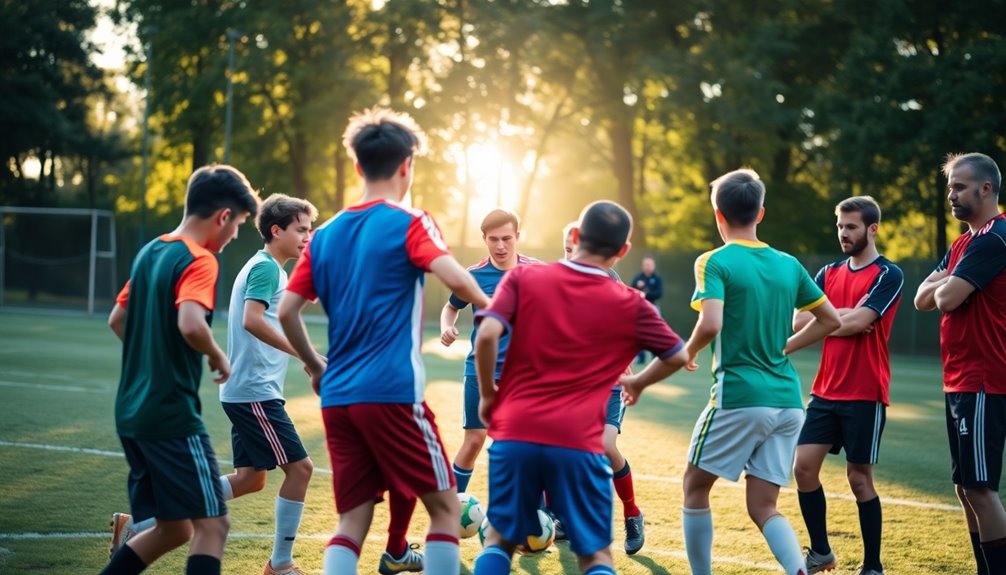
How can a simple practice drill transform communication among teammates? Rondos create an environment where verbal cues and non-verbal signals thrive.
As you engage in these fast-paced drills, your teammates constantly signal their intentions, enhancing your understanding of their communication styles. The proximity of players fosters frequent interactions, allowing you to intuitively grasp each other's playing preferences.
By practicing specific patterns, you learn to anticipate movements, building trust and collaboration on the field. Coaches can reinforce this by assigning roles, emphasizing your responsibility to effectively share information.
Regularly incorporating rondos not only sharpens your communication skills but also prepares you for high-pressure situations during matches, where clear interaction is vital for success.
Developing Quick Decision-Making Skills
In soccer, quick decision-making can be the difference between a goal and a turnover. Developing this skill is essential, and rondos serve as an excellent training tool.
They require you to enhance your cognitive processing and situational awareness, pushing you to evaluate options rapidly.
Here's how rondos can sharpen your decision-making frameworks:
- High-pressure situations force you to think on your feet.
- Limited time frames encourage swift passing and movement.
- Shooting opportunities challenge you to assess multiple options.
- Transitional drills prepare you for immediate responses after losing possession.
Fostering Creativity Through Rondo Exercises

While engaging in rondo exercises, players discover that creativity flourishes in an environment where they can experiment with passing angles and movement.
These drills serve as a platform for creativity techniques, pushing you to think outside the box and enhance your player improvisation. As you navigate tight spaces and maintain possession, your technical precision improves, boosting your confidence in executing creative plays under pressure.
The collaborative nature of rondos fosters teamwork and communication, leading to innovative strategies. By incorporating variations, like mini-goals or changing player roles, you can further stimulate tactical flexibility and adaptability in your game.
Ultimately, ronde exercises enrich your skill set, preparing you for the unpredictable nature of real-match scenarios.
Integrating High Intensity Training With Rondos
Integrating high intensity training with rondos not only elevates your fitness but also sharpens your tactical awareness.
By utilizing rondo variations like 6v6 or 4v4 plus three, you create small spaces that challenge rapid ball movement and quick decision-making.
Here's why this approach matters:
- Enhances player roles: You'll adapt your tactics on the fly.
- Promotes strategic positioning: Screening passes becomes second nature.
- Encourages agile decision-making: You'll react instantly under pressure.
- Increases training intensity: Your offensive and defensive skills get honed simultaneously.
This combination not only keeps you engaged but also prepares you for game situations, making every practice session count.
Embrace the rondo—it's your path to excellence!
Utilizing Tactical Rondo Design for Game Situations
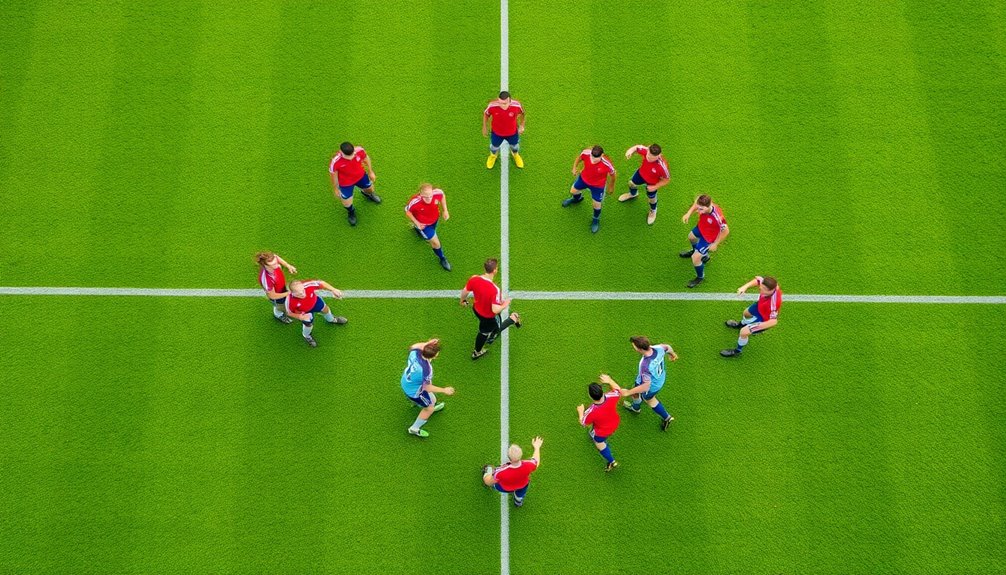
By designing tactical rondos that mirror game situations, you can elevate your players' understanding of formation and spacing. Incorporating rondo variations that reflect your team's structure, like a back four, helps players grasp their roles in build-up play.
Create wide overloads to enhance ball movement and practice shifting effectively into central spaces. Quick support underneath the ball simulates real-game scenarios, encouraging players to react swiftly and maintain possession.
Adding mini-goals for the defensive team incentivizes them to win back the ball, which mirrors competitive match situations. Emphasizing shifts with setups like 4v4 plus three fosters tactical flexibility, helping players develop sharp reactions and defensive actions after losing possession, essential for success on the field.
The Role of Support Players in Rondos
In rondos, your role as a support player is essential for maintaining possession and creating overloads.
By communicating effectively with your teammates, you can help move the ball quickly and strategically.
This not only keeps the play flowing but also opens up new passing opportunities that can outsmart defenders.
Importance of Communication
How can effective communication transform the dynamics of a soccer rondo?
It's all about fostering a supportive environment where players can thrive. When you and your teammates utilize communication strategies, it enhances your gameplay.
Here are four key benefits:
- Quick Decision-Making: Verbal cues enable faster passing sequences.
- Cohesion and Confidence: Vocal encouragement fosters creativity and risk-taking.
- Strategic Positioning: Non-verbal signals help maintain proper spacing and width.
- Enhanced Teamwork: Regular practice of communication builds stronger connections on the field.
Creating Overloads Effectively
While mastering the soccer rondo, understanding the role of support players is essential for creating effective overloads. Support player roles allow for quick passing options and enhance ball movement, vital for successful overload strategies.
By strategically positioning these players, you can create numerical advantages in specific areas, helping maintain possession and break through defensive lines. Effective communication among support players promotes seamless shifts and helps exploit gaps in the opposition's defense.
Utilizing back four and full backs as support players expands the field, providing more space for maneuvering and creating overloads during buildup play. Incorporating support players into rondos encourages you to think critically about positioning and movement, ultimately fostering a deeper understanding of tactical awareness in game situations.
Supporting Ball Movement
Support players are essential for enhancing ball movement in rondos, as they provide immediate passing options that keep the play flowing.
Their effective support hinges on strategic positioning, enabling quick shifts and overload strategies.
Here's why their role is so pivotal:
- They create passing lanes, allowing for seamless ball movement.
- Their presence encourages teammates to maintain possession under pressure.
- They dictate the rhythm and tempo, influencing the game flow.
- Their communication fosters a competitive spirit and sharpens decision-making.
Transitioning From Rondo to Game Scenarios
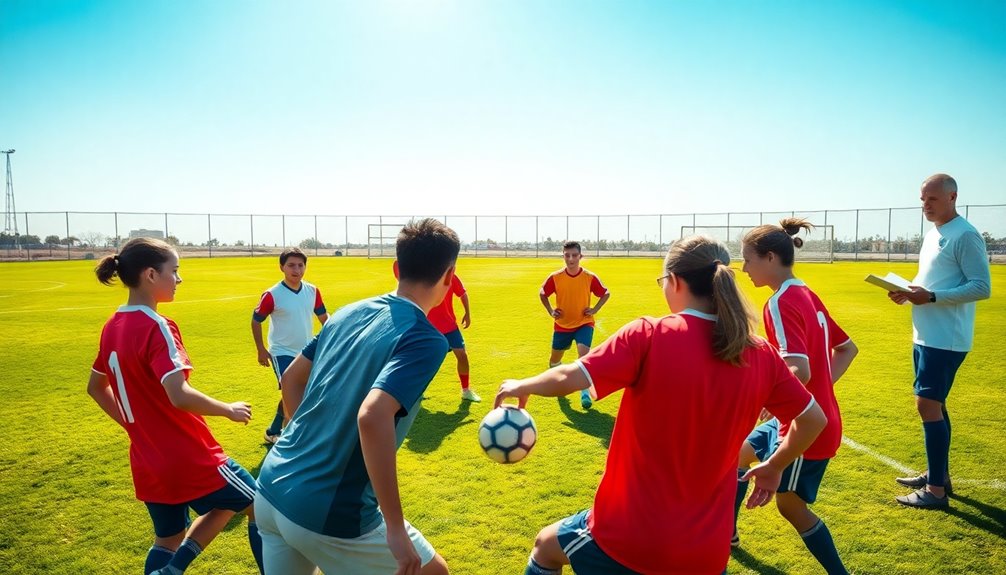
As players master the rondo, moving to game scenarios becomes essential for their development. You need to replicate the small-sided, high-pressure environment of rondos to enhance adaptability in larger match contexts.
Rondo adaptations, like incorporating specific tactical objectives such as quick ball movement and positioning, help you apply learned skills seamlessly in real games. Using breakout rondos that focus on completing a set number of passes before changing reinforces maintaining possession under pressure.
Emphasizing quick changes and sharp defensive actions during these exercises prepares you to react effectively when possession is lost. Finally, designing drills that mimic game simulation while keeping core rondo elements, like teamwork and communication, guarantees you can execute your skills in competitive environments.
Cultivating Competitive Spirit in Training
In training, healthy competition can push you and your teammates to new heights.
By challenging each other during rondo drills, you not only enhance team resilience but also boost your individual confidence.
This dynamic environment prepares everyone for high-pressure situations in real games.
Encouraging Healthy Competition
While fostering a competitive spirit in training, incorporating elements like mini-goals and time constraints can elevate players' motivation and performance. By integrating these competitive aspects into rondo drills, you'll notice significant improvements in team dynamics and individual skills.
Consider these strategies to encourage healthy competition:
- Set up scoring systems that challenge players to outscore teammates.
- Utilize small-sided games for more frequent touches, keeping everyone engaged.
- Rotate teams and positions to adapt to various playing styles.
- Create a sense of urgency with time limits, pushing players to refine their scoring strategies.
These approaches not only boost player motivation but also cultivate a fun, competitive atmosphere that enhances overall training effectiveness.
Enhancing Team Resilience
Resilience is an essential trait that every soccer player should cultivate, especially in high-pressure situations. Engaging in competitive rondo drills creates an environment where you must adapt quickly, enhancing your mental resilience.
As you navigate these high-intensity scenarios, you'll sharpen your decision-making skills, which are vital during matches. The focus on team dynamics during rondos fosters trust among teammates, allowing you to rely on each other in challenging moments.
Incorporating tactical elements like quick changes encourages a competitive mindset, pushing you to overcome obstacles together. This shared experience not only builds individual confidence but also strengthens your team's collective resilience, preparing everyone to face fierce competition head-on.
Embrace these drills, and watch your team's spirit flourish.
Boosting Individual Confidence
Confidence thrives in the dynamic environment of soccer rondos, where players face constant challenges that push them to sharpen their skills.
By engaging in these high-intensity scenarios, you'll discover effective confidence building techniques that enhance your performance.
Here's how rondos boost your self-esteem:
- Quick Decision-Making: You learn to make swift decisions under pressure.
- Communication: Expressing yourself fosters a competitive spirit and camaraderie.
- Technical Mastery: Repeated successful ball control builds belief in your abilities.
- Competitive Mindset: Competing for the ball drives your motivation strategies to improve continuously.
Incorporate these self-esteem exercises into your training, and watch as your individual confidence soars, transforming your game on the field.
Resources for Coaches to Enhance Rondo Training
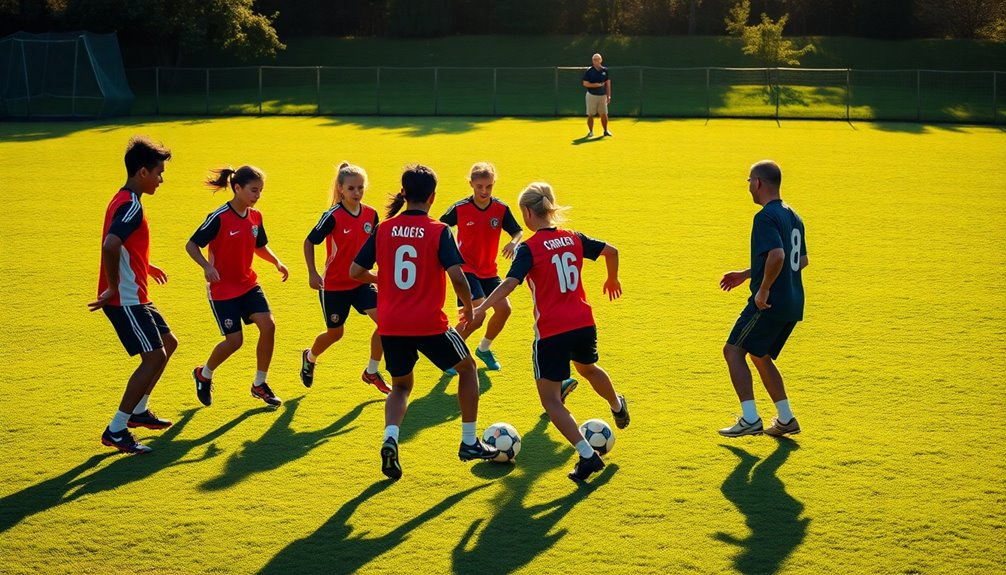
Effective training is essential for developing players' skills, and having the right resources can make a significant difference in your coaching approach.
You can access a thorough ebook featuring 14 expertly designed rondo drills at www.proacademydrills.com, perfect for enhancing your training sessions. These rondo variations are adaptable for any age group, allowing you to tailor exercises to boost player engagement effectively.
The drills focus on improving possession skills and tactical awareness, helping your players develop technical abilities and quick decision-making under pressure.
Embrace coaching philosophies that support continuous development by integrating these resources into your practices.
Don't forget to share your experiences on social media using hashtags like #FootballCoaching and #Rondos to connect with the grassroots football community!
Conclusion
Incorporating rondos into your training is like planting seeds in a garden; with care and attention, you'll cultivate a thriving team. As players dance around defenders, their technical skills blossom, and tactical awareness sharpens. Picture the vibrant energy of your squad, weaving together in perfect harmony, ready to shift seamlessly into the game. Embrace the art of the rondo, and watch your players flourish, igniting a fierce competitive spirit that drives them to victory.


